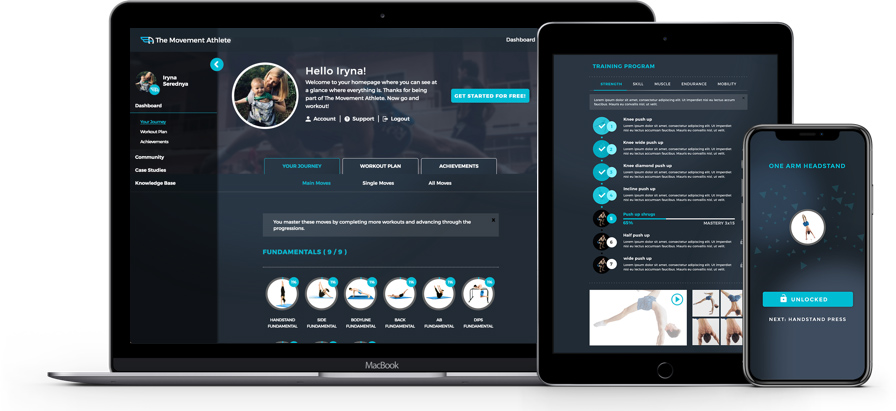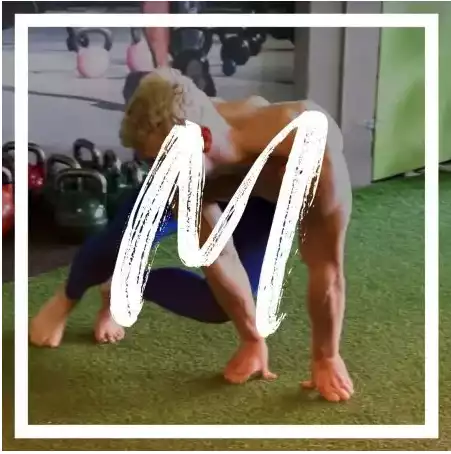The pull up bar is an essential piece of gear for any calisthenics athletes. There are hundreds of exercises that can be done with it, and today, we will show you our favourites.
This workout is beginner friendly and features progressions for every level of experience.
If you’re looking for a complete body workout that uses only the pull up bar, the floor, and the dip bars, check out one of the programs below:
- Facebook Group
- 1000+ Videos
- Mobile Progression Based App
- Online Portal
- Personalized workouts based on initial assessment
- Mobile and Desktop
- Facebook group
- A lot of encouragement to talk to coaches
- PDFs (schedules)
- Excel Files (Evaluations)
- Online Portal / Dashboard
- Videos
- Mobile and Desktop- Desktop preferred
- Add-on subjects: Nutrition, Mobility, Regeneration, Amongst Others
- Facebook Group
- Bodyweight, Kettlebell, and Dumbbell Options Available
- Videos
- Online Portal
- Mobile and desktop
- Supporting Content on Breathwork, Motivation, Warm-ups, and More!
- Facebook Group
- Sub-reddit - Extra paid "family" community
- 17 Core Classes + Extras
- Hundreds of Videos
- Online Portal
- Desktop preferred
- Supporting Content on Nutrition, Motivation, and More
- Facebook group
- Bodyweight 1.0 workout program
- Bodyweight 2.0 workout program
- Kettlebell 10-weeks
- 30-Day Challenge
- 4 Printable PDF workout calendars
- Bonus: Intro to Nutrition and Healthy Eating
- All programs come in mobile friendly and desktop versions
- All PDF programs come with links to video explanations
But anyways, back to this article’s program:
Phase 1- Warmup
Everybody’s got their own warmup routine, but here at the hybrid athlete we’re big fans of the jumping rope. 2 to 3 sets of 1 minute should be enough to get you started.
We usually add a few sets of bar hangs, twisting to the sides to stretch the lats. At least 30 seconds in each rep to really activate the upper body.
Finally, we might do burpees to get the blood flowing and increase the heart rate. A burpee is just a push-up that ends in a jump.
Running a few laps and swinging the arms is also advisable as it is really important to start the first reps with an increased heart rate and muscles warm.
Phase 2- Upper Body
You’re now ready to commence the workout. The order in which you do the exercises is up to you, but it should follow that the hardest exercises go first.
Progression 1: Pull Ups [At least 3 sets of 8 repetitions]
For many people, the pull up and its variations are the hardest exercise in the whole workout. For that reason, it is the chosen exercise to start with.
ThenX has a great video on the progression shown below:
Variation 1: Australian Pull Up
Difficulty level: Beginner
The australian pull up is a great beginner exercise. You’ll need to find a bar with adjustable height and set it to the chest or waist height, depending on how difficult you want the exercise to be. Then simply grab the bar, position yourself as if you were going to do a push up on the bar, but with your body facing upwards. and then push your body up until your chest almost touches the bar.
If this is still too hard for you, get a resistance band and attach it to your waist.
Variation 2: Normal Pull Up
Difficulty level: Intermediate
Once you can easily do at least 10 or 12 australian pull ups, you’re ready for normal pull ups. If you’re struggling initially, use a resistance band to help you propel upwards.
Make sure you keep your hands at shoulder lenght and contract your abs when you go up. Do at least 6 reps per set, and more if possible.
Variation 3: Climber Pull Up
Difficulty level: Advanced
If you’re now at a point where pull ups are a walk in the park, it’s time you progress to more advanced variations. The climber pull up is an excelent example, which combines static with dynamic movements.
Have a look at how it’s done in the video below:
Variation 4: Muscle Up
Difficulty level: advanced
The muscle-up is the quintessential calisthenics exercise. It requires precise use of momentum and strength and can take months to master. The good news is that if you can do 10 pull-ups in the bar, you have the necessary strength to do a muscle-up. The bad news, you’ll need to obsess with movement before you can get it.
ThenX has, in our opinion, the best muscle up tutorial. Have a look:
Pro tip: At the end of each set, when you feel like you can’t go any further, try jumping to the bar and control the movement downwards, trying to as slow as possible.
Progression 2: Chin-ups [ At least 3 sets of 8 repitions]
The chin-ups are a good exercise to follow from the pull up as it focuses on a slightly different set of muscles, namely the biceps. You should still be able to a few of these even after doing 3 sets of pull-ups.
Variation 1: Chin-ups
Difficulty: Intermediate
Grab the bar with your knuckles facing forwards and lift your body until at least your head has passed the bar. Repeat until you can’t do anymore reps, use bands if you are struggling and jump to the bar and come down slowly in the last reps, when you feel you can go any further.
As you get better at chin-ups, consider getting a weigth belt and add 10kg, then 20kg, etc, until you reach the weigth in which you can only do 8 reps.
Phase 3- Core
Now that you’ve given your upper body a solid warm up, its time to move on to the lower part of your body, focusing on the abs, lats, and chest. Some of these exercises will involve other muscle groups too, but the abs are one of the main muscles to work on during these exercises.
Progression 1: Levers [At least 3 sets of 5 seconds]
Athlean X has a slightly different progression than the one suggested below, but it is nonetheless, a good progression to follow:
Variation 1: Front Tuck
Difficulty: Beginner / Intermediate
Grab the bar with your hands at shoulder distance and slowly raise your feet to the bar, maintaining the core still. If you’re struggling with this first movement, practise the movement itself, which relies on core strength. Once your legs are going up, bring your knees to your chest, until your shins are facing the bar.
Hold this position for as much time as you can. Ideally, more than 5 seconds, and then release.
Variation 2: 1 Leg Front Lever
Difficulty: Intermediate
Once you can hold the front tuck for at least 10 seconds, try extending one of the legs, whilst keeping the other as close to the chest as possible. Once you master the one leg front lever for 5 seconds, try switching legs and holding for 5 seconds.
Variation 3: Normal Front Lever
Difficulty: Intermediate / Advanced
If you’re switching legs back and forth with ease, it’s time to try the normal front lever with both legs extended. Your waist should be roughly beneath the bar, and the arms and body as straigth as possible.
Hold for as long as you can.
Variation 4: Back Lever
Difficulty: Advanced
Some athletes find it easier to do the back lever than the front lever, but it really depends on the muscle groups you have most developed.
Progression 2: Leg Raises [3 sets of at least 8 repititions]
Variation 1: Knee Raises
Difficulty: Beginner / Intermediate
Grab the bar with the hands at shoulder distance, hang from the bar and raise your knees as far up as possible. Try to minimise swinging by keeping your core compact.
Variation 2: Leg Raises
Difficulty: Intermediate
Once you are fairly comfortable doing knee raises, try keeping your legs straight and bring them as high as you can. Between training sessions try doing stretches as flexibility is the core element of this exercise. Once you
Progression 3: L-sit [At least 3 sets of 5 seconds]
Variation 1: L-sit
Difficulty: Intermediate
The l-sit is probably our favorite ab exercise. It consists of lifting your legs 90º to your body whilst hanging in the bar and holding as long as you can. If at first, you don’t have the flexibility to hold this position, practice doing it with your knees bent and do stretching sessions between training sessions.
The video below is quite good at showing the steps necessary for mastering the l-sit:
Phase 4- Rest of the body
Variation 1: Bar Burpees
Difficulty: Intermediate
The bar burpee is one of the few bar exercises that also works on your cardio. You can use it as a warm-up exercise too instead of normal burpees, but we must warn you: It’s no walk in the park.
The concept is the same as burpee, but instead of just jumping in the air, you must grab the bar and do a pull-up.
Final Thoughts
These are just a few ideas of what can be done with a simple pull up bar. We hope we have convinced you that this piece of gear is pretty much all you need to get a workout done. An alternative piece of equipment are the rings, which can provide even more variations, but we’ll save that for a later post.
As always, we welcome your feedback in the comment box!

Chris is an experienced Calisthenics practitioner focused on isometric exercises and street workout. He founded thehybridathlete.com in 2017, which was subsequently acquired by theyhybridathlete.com
He is based in Portland and has been working out using solely his own body weight and bars for the past 6 years.






